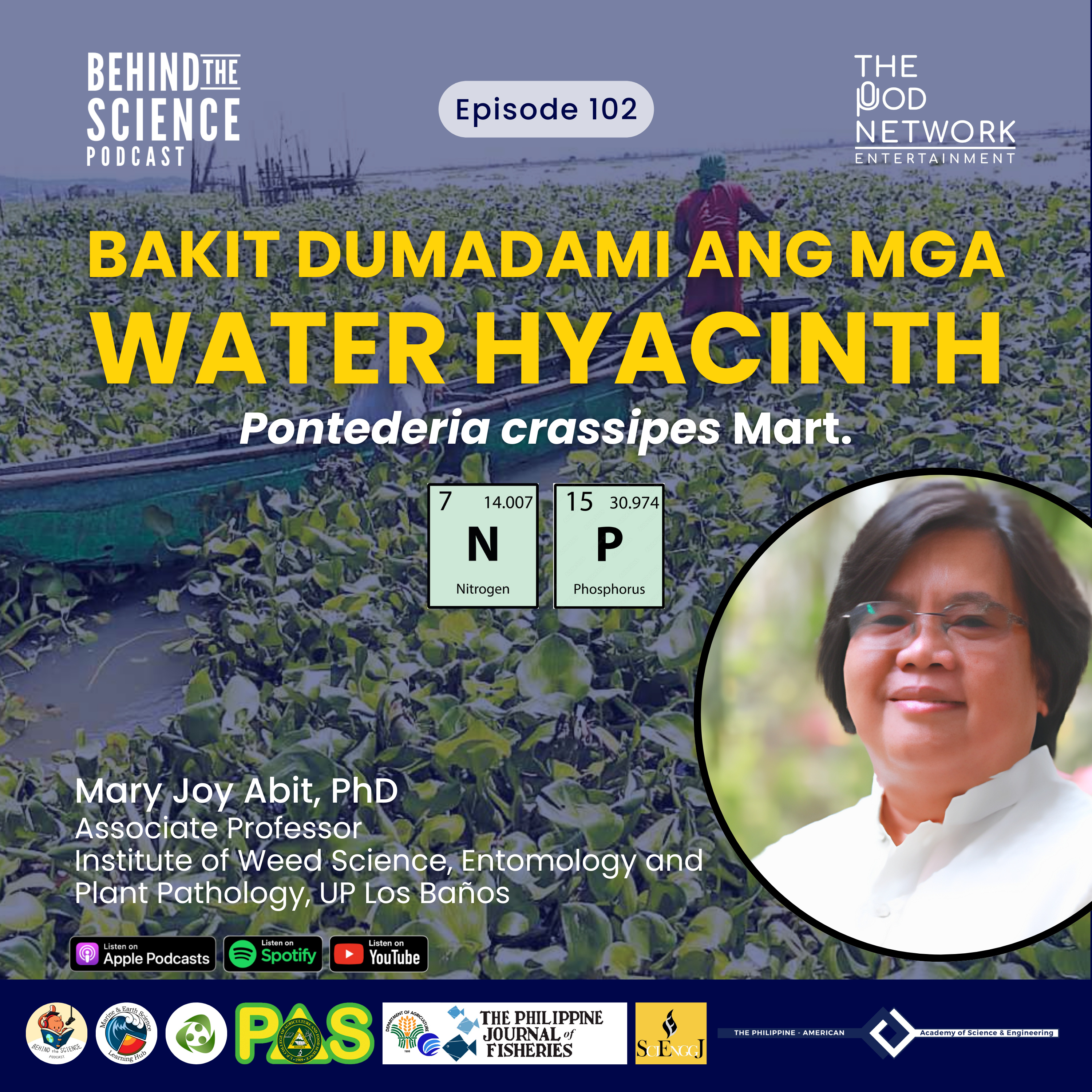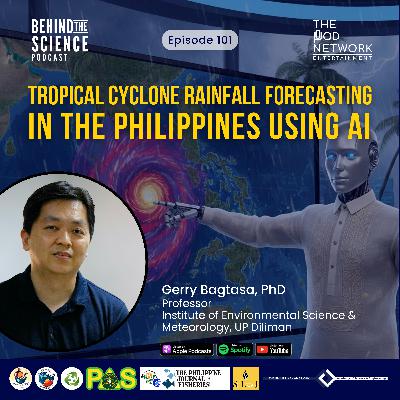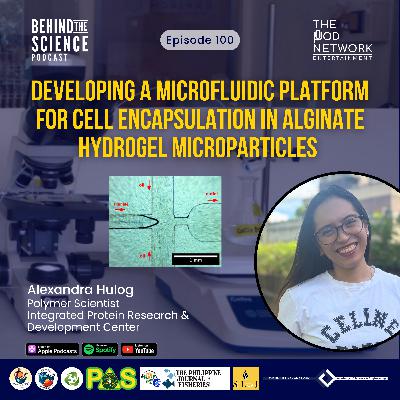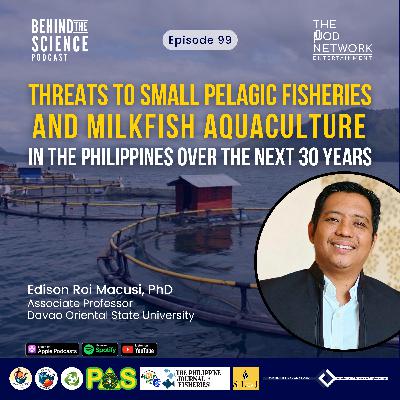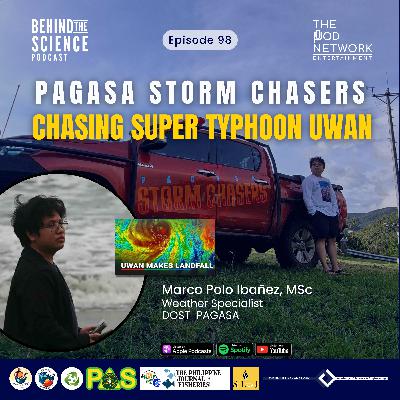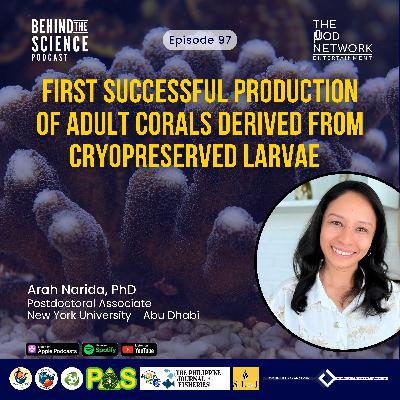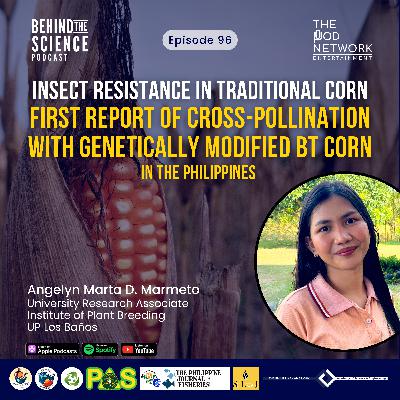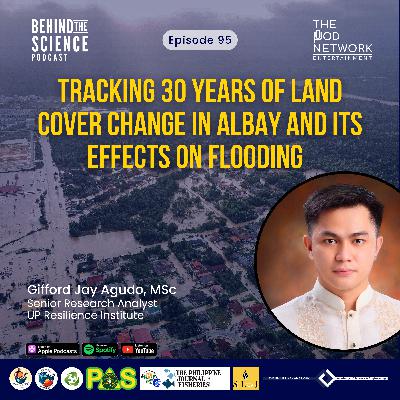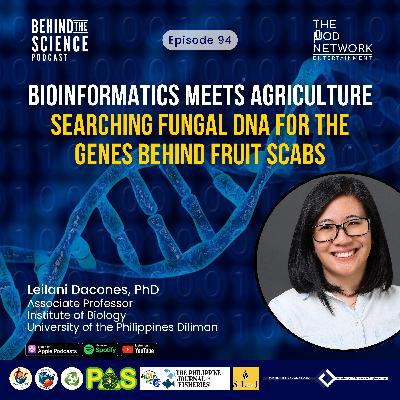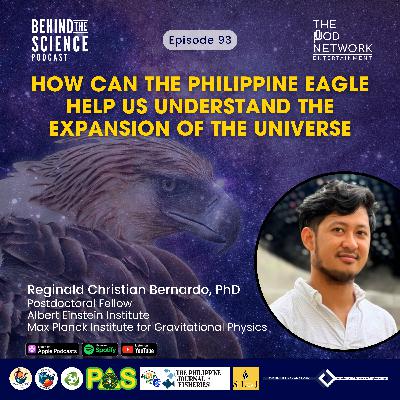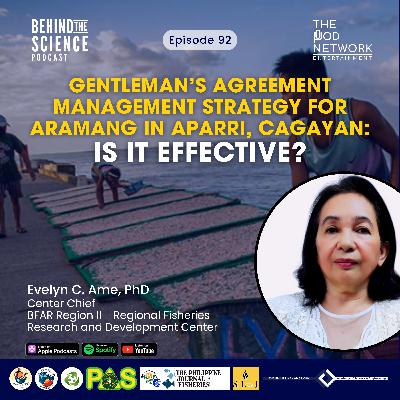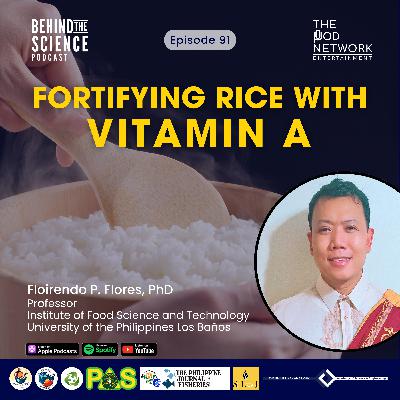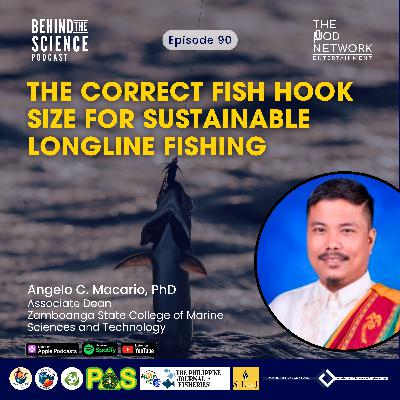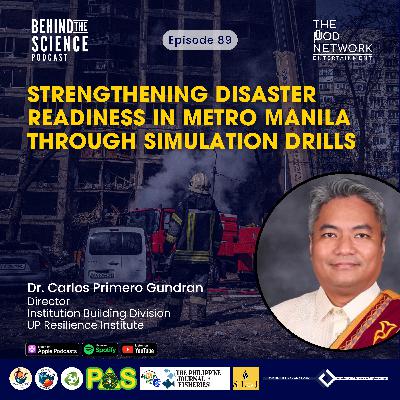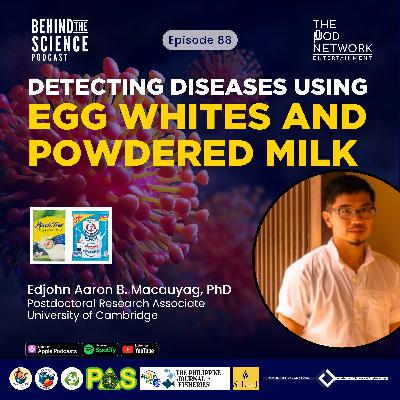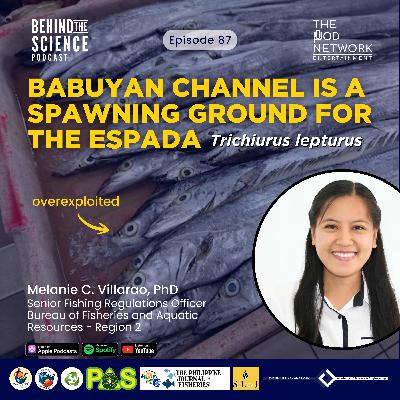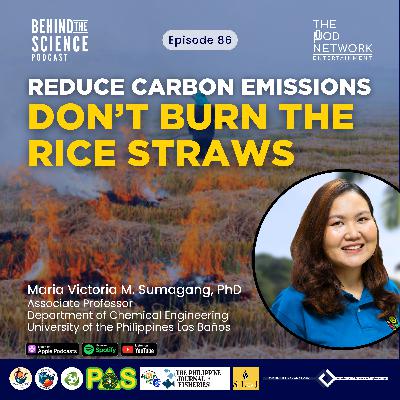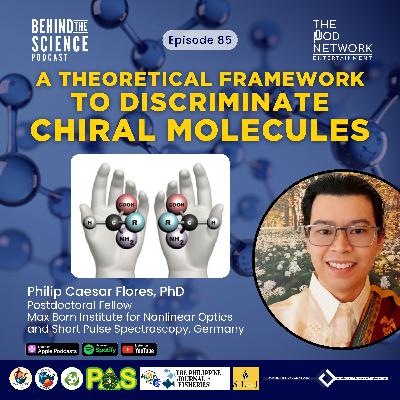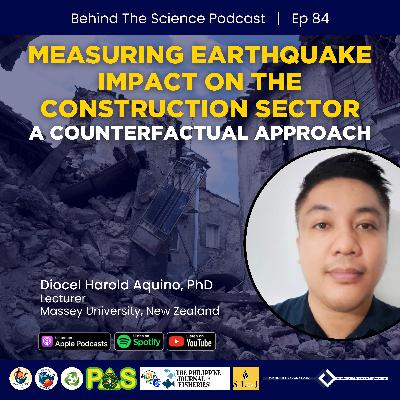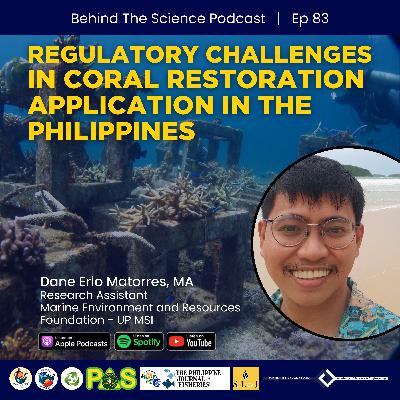Discover Behind The Science Podcast
Behind The Science Podcast

Behind The Science Podcast
Author: Paul Flores
Subscribed: 18Played: 15Subscribe
Share
© Paul Flores
Description
Every research paper holds more than just data. It carries years of dedication, sleepless nights, and setbacks. Behind The Science Podcast takes you beyond the published pages and into the real stories of discovery.
In partnership with the UP Resilience Institute, The Philippine Agricultural Scientist, The Philippine Journal of Fisheries, and SciEnggJ.
New episode every Thursday at 7:00 PM.
Hosted by: Paul Caesar M. Flores, DSc
Google Scholar: https://scholar.google.com/citations?user=6QCdWywAAAAJ&hl=en
In partnership with the UP Resilience Institute, The Philippine Agricultural Scientist, The Philippine Journal of Fisheries, and SciEnggJ.
New episode every Thursday at 7:00 PM.
Hosted by: Paul Caesar M. Flores, DSc
Google Scholar: https://scholar.google.com/citations?user=6QCdWywAAAAJ&hl=en
102 Episodes
Reverse
Dr. Mary Joy Abit shares their research that examines how nitrogen and phosphorus concentrations can influence the growth of water hyacinths.📚Reference: Abit MJ, Pilar RF, Ramirez AH. 2025. Influence of Nitrogen and Phosphorus Rates on the Growth of Water Hyacinth (Pontederia crassipes Mart.). The Philippine Agricultural Scientist. 108(1):7–12.🤝Behind The Science Podcast is presented to you by Marine & Earth Science Learning Hub, UP Resilience Institute, The Philippine Agricultural Scientist, The Philippine Journal of Fisheries, and SciEnggJ.
Dr. Gerry Bagtasa shares their study on developing an AI-based model for forecasting tropical cyclone rainfall in the Philippines using historical data from 1951 to 2015 to train the model.📚Reference: Mesias CG, Bagtasa G. 2025. AI‐Based Tropical Cyclone Rainfall Forecasting in the Philippines Using Machine Learning. Meteorological Applications. 32(4). 🤝Behind The Science Podcast is presented to you by Marine & Earth Science Learning Hub, UP Resilience Institute, The Philippine Agricultural Scientist, The Philippine Journal of Fisheries, and SciEnggJ.
In this episode, I talk with Ms. Alexandra Hulog about a new microfluidic method that creates uniform alginate microbeads for cell encapsulation. Traditional batch emulsion techniques often produce beads of uneven sizes, which affects how much medicine, nutrients, or cells each bead can carry. Their microfluidic platform solves this problem by controlling droplet size during formation, resulting in more consistent microbeads that can be used for broader biological and biotechnological applications.📚Reference: Hulog AM, Francisco M, Oquendo N, Mariane Desiree Avendaño, Kaw J, Dagdag AD, Guerrero RJ. 2025. Development of a microfluidic platform for the encapsulation of baker’s yeast Saccharomyces cerevisiae in alginate hydrogel microparticles. SciEnggJ. 18:256–269.🤝Behind The Science Podcast is presented to you by Marine & Earth Science Learning Hub, UP Resilience Institute, The Philippine Agricultural Scientist, The Philippine Journal of Fisheries, and SciEnggJ.
Dr. Edison Macusi discusses the most pressing issues facing the small pelagic fisheries and milkfish aquaculture industries in the Philippines over the next 30 years, and the solutions to these problems.📚Reference: Macusi ED, Nallos IM, Santos MD, Geronimo RC. 2025. Climate and Non-climate Related Hazards in Small Pelagic Fisheries and Milkfish Aquaculture: Expert Opinion Survey in the Philippines. The Philippine Journal of Fisheries. 32(1).🤝Behind The Science Podcast is presented to you by Marine & Earth Science Learning Hub, UP Resilience Institute, The Philippine Agricultural Scientist, The Philippine Journal of Fisheries, and SciEnggJ.
Mr. Marco Ibañez shares what it takes to become a storm chaser for the Philippine Atmospheric, Geophysical and Astronomical Services Administration, and his experience chasing Super Typhoon Uwan.📚 Check out Marco's research papers: [1] Ibañez MP, Pura AG, Sajulga RA, David SJ. 2023. Raindrop Size Distribution (RSD) Characteristics during the Southwest Monsoon Period in Western Luzon, Philippines. Philippine Journal of Science. 152(S1).► https://doi.org/10.56899/152.s1.01[2] Ibañez MPA, Capuli GH, Pura AG, Villafuerte MQ. 2025. Establishment of kinetic energy – Rainfall intensity (KE-I) relationships for soil erosion studies using raindrop size distribution (DSD) measurements in the mountainous region of Tanay, Rizal. Geomorphology. 488:109968.► https://doi.org/10.1016/j.geomorph.2025.109968🤝Behind The Science Podcast is presented to you by Marine & Earth Science Learning Hub, UP Resilience Institute, The Philippine Agricultural Scientist, The Philippine Journal of Fisheries, and SciEnggJ.
I talked with Dr. Arah Narida about a breakthrough in coral conservation. Their team achieved the world's first successful production of adult corals grown from cryopreserved larvae.📚Reference: Arah Narida, Tsai S-Y, Hsieh W-C, Wen Z, Wang L-H, Huang Cc, Lin C. 2023. First successful production of adult corals derived from cryopreserved larvae. Frontiers in Marine Science. 10.🤝Behind The Science Podcast is presented to you by Marine & Earth Science Learning Hub, UP Resilience Institute, The Philippine Agricultural Scientist, The Philippine Journal of Fisheries, and SciEnggJ.
I talked with Ms. Angelyn Marmeto about her study on the genetic interaction between BT corn and traditional maize varieties in the Philippines. Their team discovered the first evidence of natural cross-pollination, where insect-resistant traits from genetically modified corn were transferred to a native variety known as Silangan. We discuss how this gene flow happened, what it means for insect resistance, and the broader implications for agricultural biotechnology and biosafety in the country.📚Reference: Caasi-Lit, Merdelyn & Ocampo, Eureka & Salazar, Artemio & Paril, Jefferson & Novio, Bryan & Panabang, Bernard & Marmeto, Angelyn Marta. (2021). First Detection of Naturally Introgressed BT Cry1Ab in Asian Corn Borer [Ostrinia furnacalis (Guenée)]-Resistant Traditional Maize (Silangan) in the Philippines. Philippine Agricultural Scientist. 104. 340-350.🤝Behind The Science Podcast is presented to you by Marine & Earth Science Learning Hub, UP Resilience Institute, The Philippine Agricultural Scientist, The Philippine Journal of Fisheries, and SciEnggJ.
I talked with Mr. Gifford Jay Agudo about his study on land cover change and flood exposure in Quinali A Watershed, Albay. Using satellite remote sensing and flood modeling, his research tracks three decades of landscape transformation — from the loss of forests and brushlands to the rapid expansion of croplands and urban areas. The results reveal that urban growth is encroaching into flood-prone zones, nearly doubling exposure to flooding since 1990.📚Reference: Agudo GJ, Garcia J, Pulhin J, Mendoza J, Singson KV, Lagmay AMF, Cruz RV, Santiago J, Moises MA, Esquivel ALJ, et al. 2025. Land Cover Change and Its Associated Impacts on Landscape Fragmentation and Flood Exposure in Quinali A Watershed, Albay, the Philippines. Philippine Journal of Science. 154(2): 287-300.🤝Behind The Science Podcast is presented to you by Marine & Earth Science Learning Hub, UP Resilience Institute, The Philippine Agricultural Scientist, The Philippine Journal of Fisheries, and SciEnggJ.
Scab diseases make fruits like mango, citrus, and sweet potato unappealing and unmarketable, but what if we could decode the fungus behind them down to its DNA? In this episode of Behind The Science Podcast, Dr. Leilani Sumabat-Dacones talked about her team’s discovery of the genes that make the fungus Elsinoë such an effective plant pathogen. Using bioinformatics, they analyzed fungal genomes to identify effectors and toxins like elsinochrome and melanin that trigger scab formation.📚Reference: Cequeña RC, Sumabat-Dacones L. 2024. Presence of elsinochrome and other putative effectors in select genomes of the plant pathogen Elsinoë spp. based on in silico analysis. SciEnggJ. 17(1):59–70.🤝Behind The Science Podcast is presented to you by Marine & Earth Science Learning Hub, UP Resilience Institute, The Philippine Agricultural Scientist, The Philippine Journal of Fisheries, and SciEnggJ.
Dr. Reginald Bernardo shares how his recent study uses the hunting behavior of the Philippine Eagle as inspiration for optimizing cosmological models that describe the expansion of the universe. 📚Reference: Bernardo RC, Enriquez EA, Mendoza R, Reyes R, Velasco AC. 2025. Nature-inspired optimization, the Philippine Eagle, and cosmological parameter estimation. Astronomy and Computing. 54:101026. 🤝Behind The Science Podcast is presented to you by Marine & Earth Science Learning Hub, UP Resilience Institute, The Philippine Agricultural Scientist, The Philippine Journal of Fisheries, and SciEnggJ.
Dr. Evelyn Ame evaluates how the Gentleman’s Agreement — an informal management agreement among fishers — is holding up in practice for managing the stocks of aramang in Aparri, Cagayan. Using catch data, gear analysis, and participatory appraisal, Dr. Ame reveals that fishing mortality rates are much higher than natural mortality, and the current exploitation level (E = 0.66) already exceeds sustainable thresholds.📚Reference: Ame E, Laeno F, Villarao M. 2025. Status of Nematopalaemon tenuipes, Spider Prawn (Family: Palaemonidae) Stocks Caught in Aparri, Cagayan: A case of Gentleman’s Agreement Management Strategy. The Philippine Journal of Fisheries 32(1):69–80.🤝Behind The Science Podcast is presented to you by Marine & Earth Science Learning Hub, UP Resilience Institute, The Philippine Agricultural Scientist, The Philippine Journal of Fisheries, and SciEnggJ.
In this episode, I talked with Prof. Floirendo Flores about his research on fortifying rice with vitamin A. His study looked at how β-carotene can be better preserved and released using β-cyclodextrin microencapsulation. By testing different methods, the research shows how rice can be made more nutritious. This study also received the NAST PHL Outstanding Scientific Paper Award. Prof. Flores also shares his journey from chemical engineering to food science, the challenges of doing research during the pandemic, and his advice for young scientists in the Philippines. 📚Reference: Cruz, J. D., & Flores, F. (2020). Evaluation of Physicochemical Characteristics, In Vitro Release and Antioxidant Properties of β-carotene and β-cyclodextrin Inclusion Complexes with Rice as Food Matrix. The Philippine Agricultural Scientist, 103(4), 337–348.🤝Behind The Science Podcast is presented to you by Marine & Earth Science Learning Hub, UP Resilience Institute, The Philippine Agricultural Scientist, The Philippine Journal of Fisheries, and SciEnggJ.
In this episode, I talked with Dr. Angelo Macario about his study on how fishhook size affects catch variation, size selectivity, and bycatch in bottom-set longline fisheries targeting nemipterid fishes in the Philippines. His research shows that the choice of hook size plays a crucial role in determining the sustainability of fish stocks and the livelihood of small-scale fishers. Angelo also shares his journey as a researcher, the challenges of doing fieldwork in fisheries science, and his advice for aspiring scientists who want to make an impact in the field.📚Reference: Macario, A.C., Islam, T., Babaran, R.P. et al. Effects of hook size on the catch variation, size selectivity, and bycatch of the bottom set longline fisheries targeting nemipterid fishes in the Philippines. Sci Rep 15, 1379 (2025). 🤝Behind The Science Podcast is presented to you by Marine & Earth Science Learning Hub, UP Resilience Institute, The Philippine Agricultural Scientist, The Philippine Journal of Fisheries, and SciEnggJ.
In this episode of Behind the Science Podcast, I sat down with Dr. Carlos Primero Gundran to talk about disaster preparedness and response in the Philippines. He shares insights on the role of simulation training in preparing agencies for emergencies, the challenges of limited resources, and overlapping mandates. Drawing from his background in emergency medicine, Dr. Gundran highlights practical solutions and lessons learned that can help agencies and researchers strengthen disaster preparedness and save lives.📚Reference: Gundran CPD, Lam HY, Tuazon ACA, Cleofas JV, Garcia FB, Puli TEM. 2023. Simulation Training Needs Assessment for Disaster Preparedness and Disaster Response among selected agencies in National Capital Region, Philippines. International Journal of Disaster Risk Reduction. 94(2023):103824. doi:10.1016/j.ijdrr.2023.103824.🤝Behind The Science Podcast is presented to you by Marine & Earth Science Learning Hub, UP Resilience Institute, The Philippine Agricultural Scientist, The Philippine Journal of Fisheries, and SciEnggJ.
In this episode, I talked with Dr. Edjohn Aaron Macauyag about his research on developing a low-cost technique to synthesize Bst DNA polymerase —an enzyme for detecting diseases like COVID-19— and reducing costs by over 90% using home ingredients like egg whites and powdered milk.📚Reference: San Pedro VM, Cañas VA, Garcia JR, Lopez C, Zulueta M, Macauyag EA. 2025. A low-cost production method for Bst DNA polymerase (large fragment). SciEnggJ. 18(1):20–27.🤝Behind The Science Podcast is presented to you by Marine & Earth Science Learning Hub, UP Resilience Institute, The Philippine Agricultural Scientist, The Philippine Journal of Fisheries, and SciEnggJ.
In this episode of Behind the Science Podcast, we talk with Dr. Melanie Villarao about her study “Reproductive Biology and Population Dynamics of Largehead Hairtail (Trichiurus lepturus Linnaeus, 1758) in Babuyan Channel, Philippines.” They analyzed nearly 2,600 specimens of T. lepturus to determine sex ratio, fecundity, spawning seasonality, length at first maturity, and key population parameters that are essential for the sustainable management of this important commercial species.📚Reference: Villarao MC, Gumiran E, Encarnacion AB. 2023. Population Dynamics of Shortfin Scad (Decapterus macrosoma) Bleeker 1851 in Babuyan Channel, Philippines. The Philippine Journal of Fisheries 30(2):212-228.🤝Behind The Science Podcast is presented to you by Marine & Earth Science Learning Hub, UP Resilience Institute, The Philippine Agricultural Scientist, The Philippine Journal of Fisheries, and SciEnggJ.
In this episode of Behind the Science Podcast, we talked with Dr. Maria Victoria M. Sumagang about her study, “A P-graph Approach for Planning Sustainable Rice Straw Management Networks”, which received the 2025 Outstanding Scientific Paper Award by the National Academy of Science and Technology. The Philippines generates over 15 million tons of rice straw annually, much of which is still burned in fields or left to decompose—both major sources of greenhouse gas emissions. Dr. Sumagang discusses how she applied the P-graph decision support framework to evaluate sustainable and profitable alternatives for rice straw utilization, including mushroom production, pellets, and fodder.📚Reference: Migo-Sumagang MV, Promentilla MA. 2024. A P-graph Approach for Planning Sustainable Rice Straw Management Networks. The Philippine Agricultural Scientist. 107(3):253–265. 🤝Behind The Science Podcast is presented to you by Marine & Earth Science Learning Hub, UP Resilience Institute, The Philippine Agricultural Scientist, The Philippine Journal of Fisheries, and SciEnggJ.
In this episode, I talked with my twin brother Dr. Philip Flores about his research on developing a method to discriminate chiral molecules by shining a laser to the molecule and measuring the ejected electron's spin.📚Reference: Flores, P. C. M., Carlström, S., Patchkovskii, S., Ivanov, M., Mujica, V., Ordonez, A. F., & Smirnova, O. (2025). Enantiosensitive locking of photoelectron spin and cation orientation. arXiv preprint arXiv:2505.22433.⚛️ Learn physics with Pinoy Physicists at Liknayan Podcast🤝Behind The Science Podcast is presented to you by Marine & Earth Science Learning Hub, UP Resilience Institute, The Philippine Agricultural Scientist, The Philippine Journal of Fisheries, and SciEnggJ.
This episode of Behind The Science Podcast features Engr. Harold Aquino and his research on quantifying the impacts of earthquake disasters on the building construction sector using a SARIMA-based counterfactual analysis. 📚Reference: Aquino DHM, Domingo N, Atapattu C. 2025. Evaluating the impacts of earthquake disasters on the building construction sector: a SARIMA-based counterfactual analysis. International Journal of Disaster Risk Reduction. 127:105695. doi:10.1016/j.ijdrr.2025.105695.🤝Behind The Science Podcast is presented to you by Marine & Earth Science Learning Hub, UP Resilience Institute, The Philippine Agricultural Scientist, The Philippine Journal of Fisheries, and SciEnggJ.
In this episode, we talk with Mr. Erlo Matorres about the realities of coral reef restoration in the Philippines. We discussed the challenges practitioners face, such as the limited understanding of the guidelines and necessary permits before implementing a restoration project.📚Reference: Matorres DE, Fabinyi M, Horigue V, Novilla CT, Baria-Rodriguez MV. 2024. Institutional dimensions of coral reef restoration in the Philippines. Environmental Science & Policy. 156:103734.🤝Behind The Science Podcast is presented to you by Marine & Earth Science Learning Hub, UP Resilience Institute, The Philippine Agricultural Scientist, The Philippine Journal of Fisheries, and SciEnggJ.




